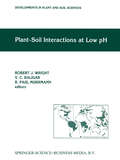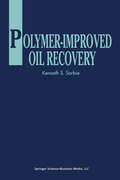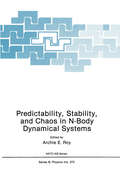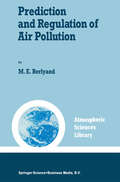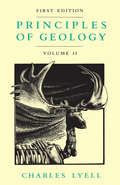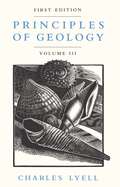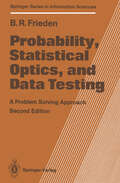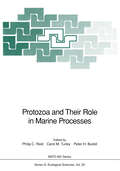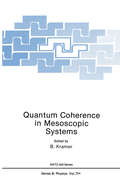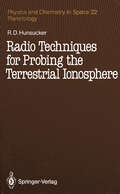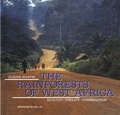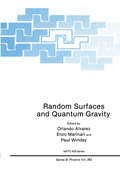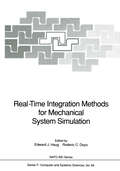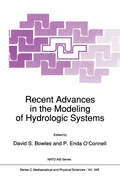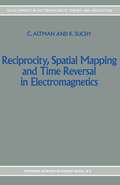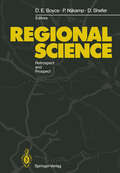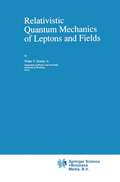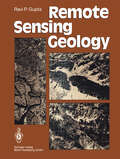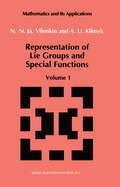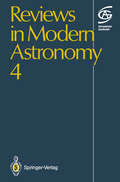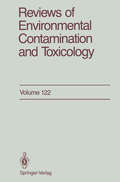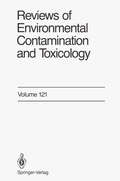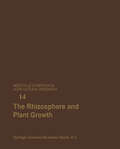- Table View
- List View
Plant-Soil Interactions at Low pH: Proceedings of the Second International Symposium on Plant-Soil Interactions at Low pH, 24–29 June 1990, Beckley West Virginia, USA (Developments in Plant and Soil Sciences #45)
by Robert J. Wright V. C. Baligar R. Paul MurrmannSoil acidity is a major limitation to crop production in many parts of the world. Plant growth inhibition results from a combination of factors, including aluminum, manganese, and hydrogen ion toxicities and deficiencies of essential elements, particularly calcium, magnesium, phosphorus, and molybdenum. Agricultural management practices and acid precipitation have increased acid inputs into the ecosystem and heightened concern about soil acidity problems. While application of lime has proved to be effective in ameliorating surface soil acidity in many areas, significant soil acidity problems still exist. Scientists from Alberta, Canada, recognized the need to provide a forum for researchers from different disciplines to exchange information and ideas on solving problems of plant growth in acid soils. As a result of their efforts, the First International Symposium on Plant-Soil Interactions at Low pH was held at Grande Prairie, Alberta, Canada, in July 1987. In many acid soil areas, liming materials are not readily available, the cost may be prohibitive, or subsoil acidity cannot be corrected by surface application of lime. New management approaches involving both the plant and the soil are needed in these situations. Progress has been made in the selection and breeding of acid-tolerant plants. However, continued progress will be limited by our lack of understanding of the physiological and biochemical basis of differential acidity tolerance among plants.
Polymer-Improved Oil Recovery
by K.S. SorbieThe importance of oil in the world economy cannot be overstated, and methods for recovering oil will be the subject of much scientific and engineering research for many years to come. Even after the application of primary depletion and secondary recovery processes (usually waterflooding), much oil usually remains in a reservoir, and indeed in some heterogeneous reservoir systems as much as 70% of the original oil may remain. Thus, there is an enormous incentive for the development of improved or enhanced methods of oil recovery, aimed at recovering some portion of this remainil)g oil. The techniques used range from 'improved' secondary flooding methods (including polymer and certain gas injection processes) through to 'enhanced' or 'tertiary' methods such as chemical (surfactant, caustic, foam), gas miscible (carbon dioxide, gas reinjection) and thermal (steam soak and drive, in-situ combustion). The distinction between the classification ofthe methods usually refers to the target oil that the process seeks to recover. That is, in 'improved' recovery we are usually aiming to increase the oil sweep efficiency, whereas in 'tertiary' recovery we aim to mobilise and recover residual or capillary trapped oil. There are a few books and collections of articles which give general overviews of improved and enhanced oil recovery methods. However, for each recovery method, there is such a wide range of interconnected issues concerning the chemistry, physics and fluid mechanics of flow in porous media, that rarely are these adequately reviewed.
Predictability, Stability, and Chaos in N-Body Dynamical Systems (Nato Science Series B: #272)
by Archie E. RoyThe reader will find in this volume the Proceedings of the NATO Advanced Study Institute held in Cortina d'Ampezzo, Italy between August 6 and August 17, 1990 under the title "Predictability, Stability, and Chaos in N-Body Dynamical Systems". The Institute was the latest in a series held at three-yearly inter vals from 1972 to 1987 in dynamical astronomy, theoretical mechanics and celestial mechanics. These previous institutes, held in high esteem by the international community of research workers, have resulted in a series of well-received Proceedings. The 1990 Institute attracted 74 participants from 16 countries, six outside the NATO group. Fifteen series of lectures were given by invited speakers; additionally some 40 valuable presentations were made by the younger participants, most of which are included in these Proceedings. The last twenty years in particular has been a time of increasingly rapid progress in tackling long-standing and also newly-arising problems in dynamics of N-body systems, point-mass and non-point-mass, a rate of progress achieved because of correspondingly rapid developments of new computer hardware and software together with the advent of new analytical techniques. It was a time of exciting progress culminating in the ability to carry out research programmes into the evolution of the outer Solar 8 System over periods of more than 10 years and to study star cluster and galactic models in unprecedented detail.
Prediction and Regulation of Air Pollution (Atmospheric and Oceanographic Sciences Library #14)
by M.E. BerlyandInvestigations of atmospheric pollution have recently reached a new stage. In addition to the estimation and the monitoring of pollutant concentrations in the air around their sources, by way of observational data and also by calcu lations on the basis of theoretical research, it is now possible to make short term forecasts of air pollution and to use them to regulate industrial emissions. Many countries are interested in such forecasts. In the Soviet Union the organizations of the State Committee of the USSR for Hydrometeorology (Goskomgidromet) are carrying out a wide-scale scientific programme on the devising of methods to forecast atmospheric pollution. Prognostic groups are organized in territorial hydrometeocenters; in essence a new forecasting service has been established. Nowadays, in more than 200 towns of the USSR predictions are made and transmitted to large enterprises for the purpose of taking the necessary steps to preserve air qua lity. To ensure an operative working of this service, Methodological Instruc (1979) have been issued, as well as other instructions and guides. Wide tions scale verifications of proposed calculating methods have been made. Prob lems of forecasting and regulating air pollution have become evident lately in other countries as well. Much attention to these problems is payed by the World Meteorological Organization (WMO). They have been widely dis cussed in a number of international conferences and meetings for modelling and investigating pollutant distribution in the atmosphere. The number of publications on this subject is rapidly increasing.
Principles of Geology, Volume 2
by Charles LyellAs important to modern world views as any work of Darwin, Marx, or Freud, Lyell's Principles of Geology has never before been available in paperback. In the second of three volumes, Lyell (1797-1875) continues his uniformitarian argument of Volume I—the physical features of the earth are endlessly fluctuating around a stable mean—but focuses on organic rather than inorganic processes. Volume II is widely known because of its influence on Darwin, who took the book on his famous Beagle voyage and was stimulated by Lyell's extensive treatment of biological history and diversity.
Principles of Geology, Volume 2
by Charles LyellAs important to modern world views as any work of Darwin, Marx, or Freud, Lyell's Principles of Geology has never before been available in paperback. In the second of three volumes, Lyell (1797-1875) continues his uniformitarian argument of Volume I—the physical features of the earth are endlessly fluctuating around a stable mean—but focuses on organic rather than inorganic processes. Volume II is widely known because of its influence on Darwin, who took the book on his famous Beagle voyage and was stimulated by Lyell's extensive treatment of biological history and diversity.
Principles of Geology, Volume 2
by Charles LyellAs important to modern world views as any work of Darwin, Marx, or Freud, Lyell's Principles of Geology has never before been available in paperback. In the second of three volumes, Lyell (1797-1875) continues his uniformitarian argument of Volume I—the physical features of the earth are endlessly fluctuating around a stable mean—but focuses on organic rather than inorganic processes. Volume II is widely known because of its influence on Darwin, who took the book on his famous Beagle voyage and was stimulated by Lyell's extensive treatment of biological history and diversity.
Principles of Geology, Volume 3 (Principles Of Geology Ser. #Vol. 3)
by Charles LyellAs important to modern world views as any work of Darwin, Marx, or Freud, Lyell's Principles of Geology has never before been available in paperback. In this third and final volume, Charles Lyell (1797-1875) devotes much attention to the "syntax of geology," that is, to a way of reconstructing the geological past on the basis of the "grammar" of the present processes he has described in the earlier volumes. He defines four periods of the Tertiary—Newer Pliocene, Older Pliocene, Miocene, and Eocene—and argues that the deposits dating from each period demonstrate the uniformity of processes and environments throughout the Tertiary, and indeed in earlier periods of earth history. Martin J. S. Rudwick has compiled a bibliography giving full references for the sources Lyell cites in all three volumes of the Principles.
Probability, Statistical Optics, and Data Testing: A Problem Solving Approach (Springer Series in Information Sciences #10)
by B.Roy FriedenThis new edition incorporates corrections of all known typographical errors in the first edition, as well as some more substantive changes. Chief among the latter is the addition of Chap. 17, on methods of estimation. As with the rest of the text, most applications and examples cited in the new chapter are from the optical perspective. The intention behind this new chapter is to empower the optical researcher with a yet broader range of research tools. Certainly a basic knowledge of estimation methods should be among these. In particular, the sections on likelihood theory and Fisher information prepare readers for the problems of optical parameter estimation and probability law estimation. Physicists and optical scientists might find this material particularly useful, since the subject of Fisher information is generally not covered in standard physical science curricula. Since the words "statistical optics" are prominent in the title of this book, their meaning needs to be clarified. There is a general tendency to overly emphasize the statistics of photons as the sine qua non of statistical optics. In view is taken, which equally emphasizes the random medium this text a wider that surrounds the photon, be it a photographic emulsion, the turbulent atmo sphere, a vibrating lens holder, etc. Also included are random interpretations of ostensibly deterministic phenomena, such as the Hurter-Driffield (H and D) curve of photography. Such a "random interpretation" sometimes breaks new ground, as in Chap.
Protozoa and Their Role in Marine Processes (Nato ASI Subseries G: #25)
by P. C. Reid C. M. Turley P. H. BurkillIn the summer of 1988, under NATO sponsorship, approximately 80 scientists lived and worked together in Plymouth for two weeks to evaluate the ecological role of protozoa in the sea. Through the convivial surroundings, close working conditions and special facilities that had been brought together for NATO ASI 604/87 a 'melting pot' of ideas was formed, which stimulated the multidisciplinary creativity which is expressed in this book and in a second series of papers which will be published in Marine Microbial Food Webs under the title - "Protozoa and their Role in Marine Microbial Food Webs". Discussions of the role of protozoa in the microbial food web, in the cycling of carbon and nitrogen and the extent to which this web acts as a link or sink to metazoa in the water column were major themes of the ASI. Structured sessions covering oral and poster presentations, field work, model 1 ing, laboratory practicals and demonstrations of techniques such as image analysis and flow cytometry, formed the core of the meeting. Participants took part enthusiastically in the practical sessions developing new concepts and obtaining new insights into their work. The practicals included a 'protozoo' and some beautiful films and videos. Field excursions were made to a range of sites including a unique marine sewage farm at Looe in Cornwall, (Jones this volume). Interactive workshops allowed scientists with no modelling experience to input their results to three simulation models and a flow analysis package.
Quantum Coherence in Mesoscopic Systems (Nato Science Series B: #254)
by B. KramerProceedings of a NATO ASI held in Les Arcs, France, April 2--13, 1990
Radio Techniques for Probing the Terrestrial Ionosphere (Physics and Chemistry in Space #22)
by Robert D. HunsuckerIn the years since the pioneering efforts of Sir Edward Appleton, M. A. F. Barnett, G. Breit, and M. A. Thve, many radio techniques have been employed to investigate the terrestrial ionosphere. The purposes of this book are to exam ine the basic physical interaction process of radio waves with the ionosphere, scrutinize each of the radio techniques currently in use, and describe the elements of each technique, as well as assess their capabilities and limitations. I have included some of the history of each technique, since we often tend to forget the efforts of the "pioneers". The interaction of radio waves with the terrestrial ionosphere has been described in considerable detail in several "classic" treatments, e.g., Ratcliffe (1959), Al'pert (1963), Budden (1961) and Davies (1965), Rishbeth and e.g., Flock (1979), Davies Garriott (1969), and in other more recent books, (1990), Hargreaves (1979), and Budden (1985). A few of the radio techniques have been described by Hargreaves (1979) and a book by Giraud and Petit (1978) has also included discussion of several of the techniques. The "WITS" handbook No. 2 (1989) also contains description of several radio techniques.
The Rainforests of West Africa: Ecology — Threats — Conservation
by MARTINNowhere eise in the world did industrialized countries leave such early marks in the rainforest as in West Africa. Past and present developments here are in one way or the other significant for rainforests on other continents as weil. West Africa is a pioneer in both a good and a bad sense. This is reason enough to take a closer Iook at the history of moist tropical West Africa. Until recently, no one really seemed to be interested in the rainforests except for a few specialists. The world's scientific community neglected to study the incalculable riches of tropical forests, to make the public aware of them and their due importance. Although interdisciplinary research has been a popular topic for some decades now, it was not applied to just the most complex habitat on earth. Scientists from all fields studied only that which was easiest to record, seemingly blind to a myriad of details awaiting closer examination. Botanists wentabout establishing their herbariums and paid much too little attention to the vegetation as a whole, or to the significance of useful plants for local populations. Zoologists, too, busied themselves with collecting and describing species. Anthropologists, on the other hand, tended to overlook faunal details: in their ignorance of the animal world, they wrote of tigers and deer in Africa. And finally, foresters saw neither the forest nor the trees for the timber - and even confused rainforests with monocultures of fir trees.
Random Surfaces and Quantum Gravity (Nato Science Series B: #262)
by Orlando Alvarez Enzo Marinari Paul WindeyThe Cargese Workshop Random Surfaces and Quantum Gravity was held from May 27 to June 2, 1990. Little was known about string theory in the non-perturbative regime before Oetober 1989 when non-perturbative equations for the string partition functions were found by using methods based on the random triangulations of surfaees. This set of methods pro vides a deseription of non-eritical string theory or equivalently of the coupling of matter fields to quantum gravity in two dimensions. The Cargese meeting was very successful in that it provided the first opportunity to gather most of the active workers in the field for a fuH week of lectures and extensive informal discussions about these exeiting new developments. The main results were reviewed, recent advances were explained, new results and conjectures (which appear for the first time in these proceedings) were presented and discussed. Among the most important topics discussed at the workshop were: The relation of KdV theory to loop equations and the Virasoro algebra, new results in Liouville field theory, effective (1 + 1) dimensional theory for 2 - D quantum gravity coupled to c = 1 matter and its fermionization, proposal for a new geometrical interpretation of the string equation and possible definition of quantum Riemann surfaces, discussion of the string equation for the multi-matrix models, links with topological field theories of gravity, issues in using target space supersymmetry to define good theories, definition of the partition function via analytic continuation, new models of random surfaces
Real-Time Integration Methods for Mechanical System Simulation (NATO ASI Subseries F: #69)
by Edward J. Haug Roderic C. DeyoThis book contains the edited versions of lectures and selected contributed papers presented at the NATO Advanced Research Workshop on Real-Time Integration Methods For Mechanical System Simulation, held in Snowbird, Utah, August 7-11, 1989. The Institute was attended by 42 participants from 9 countries, including leading mathematicians and engineers from universities, research institutions, and industry. The majority of participants presented either invited or contributed papers during the Institute, and everyone participated in lively discussions on scientific aspects of the program. The Workshop provided a forum for investigation of promising new directions for solution of differential-algebraic equations (DAE) of mechanical system dynamics by mathematicians and engineers from numerous schools of thought. The Workshop addressed needs and opportunities for new methods of solving of DAE of mechanical system dynamics, from the perspective of a broad range of engineering and scientific applications. Among the most exciting new applications addressed was real time computer simulation of mechanical systems that, for the first time in human history, permits operator-in-the-Ioop simulation of equipment that is controlled by the human; e.g., driving a vehicle, operating a space telerobot, operating a remote manipulator, and operating construction equipment. The enormous potential value of this new application and the fact that real-time numerical integration methods for DAE of mechanical system dynamics is the pacing problem to be solved in realizing this potential served to focus much of the discussion at the Workshop.
Recent Advances in the Modeling of Hydrologic Systems (Nato Science Series C: #345)
by D. S. Bowles P. Enda O'ConnellModeling of the rainfall-runoff process is of both scientific and practical significance. Many of the currently used mathematical models of hydrologic systems were developed a genera tion ago. Much of the effort since then has focused on refining these models rather than on developing new models based on improved scientific understanding. In the past few years, however, a renewed effort has been made to improve both our fundamental understanding of hydrologic processes and to exploit technological advances in computing and remote sensing. It is against this background that the NATO Advanced Study Institute on Recent Advances in the Modeling of Hydrologic Systems was organized. The idea for holding a NATO ASI on this topic grew out of an informal discussion between one of the co-directors and Professor Francisco Nunes-Correia at a previous NATO ASI held at Tucson, Arizona in 1985. The Special Program Panel on Global Transport Mechanisms in the Geo-Sciences of the NATO Scientific Affairs Division agreed to sponsor the ASI and an organizing committee was formed. The committee comprised the co directors, Professor David S. Bowles (U.S.A.) and Professor P. Enda O'Connell (U.K.), and Professor Francisco Nunes-Correia (Portugal), Dr. Donn G. DeCoursey (U.S.A.), and Professor Ezio Todini (Italy).
Reciprocity, Spatial Mapping and Time Reversal in Electromagnetics (Developments in Electromagnetic Theory and Applications #9)
by C. Altman K. SuchyThe choice of topics in this book may seem somewhat arbitrary, even though we have attempted to organize them in a logical structure. The contents reflect the path of 'search and discovery' followed by us, on and off, for the in fact last twenty years. In the winter of 1970-71 one of the authors (C. A. ), on sah baticalleave with L. R. O. Storey's research team at the Groupe de Recherches Ionospheriques at Saint-Maur in France, had been finding almost exact symme tries in the computed reflection and transmission matrices for plane-stratified magnetoplasmas when symmetrically related directions of incidence were com pared. At the suggestion of the other author (K. S. , also on leave at the same institute), the complex conjugate wave fields, used to construct the eigenmode amplitudes via the mean Poynting flux densities, were replaced by the adjoint wave fields that would propagate in a medium with transposed constitutve tensors, et voila, a scattering theorem-'reciprocity in k-space'-was found in the computer output. To prove the result analytically one had to investigate the properties of the adjoint Maxwell system, and the two independent proofs that followed, in 1975 and 1979, proceeded respectively via the matrizant method and the thin-layer scattering-matrix method for solving the scattering problem, according to the personal preferences of each of the authors. The proof given in Chap. 2 of this book, based on the hindsight provided by our later results, is simpler and much more concise.
Regional Science: Retrospect and Prospect
by David Boyce Peter Nijkamp Daniel SheferRegional science, as an integrating discipline for many scientific analyses concerning the element of space, has a remarkable record of achievements in both breadth and depth. The great many scientific journals in this field and the large number of regional science books mirror the appeal of this discipline, in both the developed and the developing world. The scientific organization in this area, the Regional Science Association International, is organizing a world conference every four years. The 1989 Regional Science World Conference was held in an interesting setting, viz. kibbutz Ramat Rachel on the outskirts of Jerusalem. The organization of this meeting was undertaken by the Israeli Section of the Regional Science Association, under the supervision of Professor Rafi Bar-EI (Development Study Center, Rehovoth). The meeting turned out to be a great success and provided an extremely interesting cross-section of new developments in the area of regional science. It was decided afterward to publish a set of representative papers from this meeting in one volume. The present book brings together these papers, which were duly selected after a careful screening and refereeing process. The editors wish to thank all referees for their willingness to assist them in the task of producing this volume. Many thanks also go to Rita Hittema for her skillful copy-editing and word processing of the manuscript.
Relativistic Quantum Mechanics of Leptons and Fields (Fundamental Theories of Physics #41)
by W.T. GrandyThe material contained in this work concerns relativistic quantum mechanics, and as such pertains to classical fields. On the one hand it is meant to serve as a text on the subject, a desire stemming from the author's fruitless searches for an adequate, up-to-date reference when lecturing on these topics. At times the supplementary material was found to exceed by far that in the assigned text. On the other hand, there is some flavor of a monograph to what follows, most particularly in the later chapters, for a major goal is to demonstrate just how far we can advance our understanding of the behavior of stable particles and their interactions without introducing quantized fields. Those wishing to describe the world in this way may view the result as a point of departure, despite the fact that their wish remains unfulfilled. Confirmed quantum-field theorists, however, will doubtless view it as a summary of just why they feel compelled to quantize the fields. Approximately half the book is devoted to the single-particle Dirac equation and its solutions. A great deal of detail is provided in this respect, and the discus sion is reasonably comprehensive. The Dirac equation is extraordinarily important in its own right, particularly as a basis for quantum electrodynamics (QED), and is thus worthy of extensive study.
Remote Sensing Geology
by Ravi P. GuptaThere has been phenomenal growth in the field of remote sensing over the last two to three decades. It has been applied in the fields of geology, mineral exploration, forestry, agriculture, hydrology, soils, land use etc. - that is, in all pursuits of sciences dealing with the features, processes, and phenomena operating at the earth's surface. The status of geological remote sensing has rapidly advanced and the scientific literature is scattered. The aim of the present book is to systematically discuss the specific requirements of geological remote sensing, to summarize the techniques of remote sensing data collection and interpretation, and to integrate the technique into geoexploration. The main conceptual features of the book are: - To combine various aspects of geological remote sensing, ranging from the laboratory spectra of minerals and rocks to aerial and space-borne remote sensmg. - To integrate photogeology into remote sensing. - To promote remote sensing as a tool in integrated geoexploration. - To elucidate the wide-spectrum geoscientific applications of remote sensing, ranging from meso- to global scale. The book has been written to satisfy the needs of mainly graduate students and active research workers interested in applied earth sciences. It is primarily concept -oriented rather than system- or module-oriented.
Representation of Lie Groups and Special Functions: Volume 1: Simplest Lie Groups, Special Functions and Integral Transforms (Mathematics and its Applications #72)
by N.Ja. Vilenkin A.U. KlimykReviews in Modern Astronomy (Reviews in Modern Astronomy #4)
by Gerhard KlareThe yearbook series Reviews in Modern Astronomy of the Astronomische Gesell three years ago in order to bring the scientific events schaft (AG) was established of the meetings of the society to the attention of the worldwide astronomical community. Reviews in Modern Astronomy is devoted exclusively to the invited reviews, the Karl Schwarzschild lectures, and the highlight contributions from leading scientists reporting on recent progress and scientific achievements at their research institutes. Volume 4 comprises all, eighteen contributions which were presented during the fall meeting of the AG at Preiburg/Breisgau in September 1990. They cover problems in solar research and the solar system as well as the first results of the ROSAT and Hipparcos space missions, stellar and extragalactic studies, and Supernova 1987A in the Large Magellanic Cloud. The Karl Schwarzschild Medal was awarded to Professor Eugene Parker1. His lecture entitled "Convection, Spontaneous Discontinuities, and Stellar Winds and X-Ray Emis·sion" begins this volume.
Reviews of Environmental Contamination and Toxicology: Continuation of Residue Reviews (Reviews of Environmental Contamination and Toxicology #122)
by George W. WareReviews of Environmental Contamination and Toxicology publishes authoritative reviews on the occurrence, effects, and fate of pesticide residues and other environmental contaminants. It will keep you informed of the latest significant issues by providing in-depth information in the areas of analytical chemistry, agricultural microbiology, biochemistry, human and veterinary medicine, toxicology, and food technology.
Reviews of Environmental Contamination and Toxicology: Continuation of Residue Reviews (Reviews of Environmental Contamination and Toxicology #121)
by George W. WareReviews of Environmental Contamination and Toxicology publishes authoritative reviews on the occurrence, effects, and fate of pesticide residues and other environmental contaminants. It will keep you informed of the latest significant issues by providing in-depth information in the areas of analytical chemistry, agricultural microbiology, biochemistry, human and veterinary medicine, toxicology, and food technology.
The Rhizosphere and Plant Growth: Papers presented at a Symposium held May 8–11, 1989, at the Beltsville Agricultural Research Center (BARC), Beltsville, Maryland (Beltsville Symposia in Agricultural Research #14)
by Donald L. Keister Perry B. CreganPapers Presented at a Symposium held May 8--11, 1989, at the Beltsville Agricultural Research Center (BARC), Beltsville, Maryland, U.S.A.
